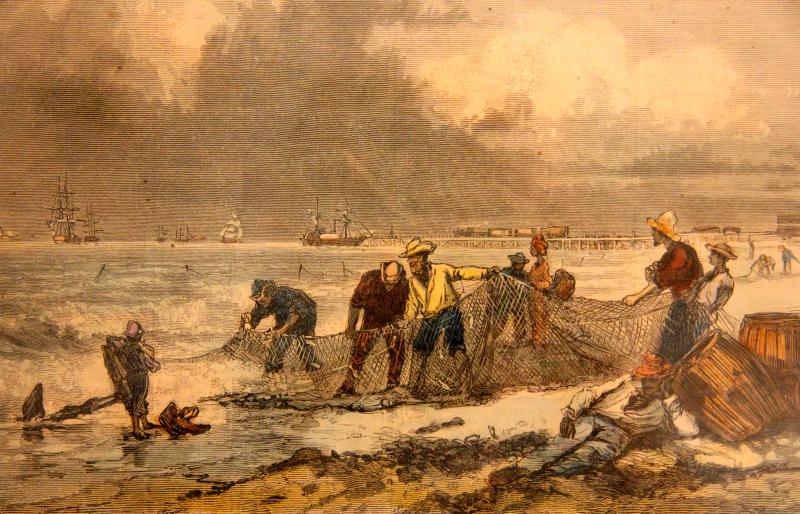Rare original fishing art hangs in Lewes museum
Back in August, I rolled out a historic illustration from Harper’s Magazine showing people in Lewes croaker fishing with a seine net on Lewes Beach. We published it as part of our historic photo feature that runs on page 7 in our Tuesday edition. I can’t even tell you where the illustration came from. Someone dropped it off years ago and it lives in a bulging file of historic items in drawer in my desk.
The illustration beckons me every four years or so. I shuffle through the file, pull it out and once again allow my eyes to pour over the details that caught the artist’s eye back in 1877 when it was first drawn and published.
This time around, Mike DiPaolo at Lewes Historical Society called me with some news. “Hey Dennis,” he said, “you know that croaker fishing illustration you published recently? We have the original artist’s drawing hanging on the wall in our Maritime Museum. The original! Originals of those illustrations are very rare. One from Lewes, Del., to make its way through time is remarkable.”
Before the age of photography took hold, publishers used artist illustrations to show their readers across the country what people in other parts of the country were doing. The firm of Frederic Schell and Thomas Hogan became famous for illustrations of famous battles and other scenes from this nation’s Civil War, or, as former Lewes Postmaster Henry Marshall preferred to call the conflict, The War Between the States. They employed artists to join them in their work. After the conclusion of the war, their illustrations captured more quotidian aspects of American life.
The original drawing is not as detailed as the final drawing that made it into print. Some elements have shifted position, such as schooners - some at anchor, some under sail - making their way across Breakwater Harbor. The position of a steaming train engine rolling out onto the Queen Anne Pier is also different on the original. But mostly they’re the same, capturing the mood of Lewes residents pulling fish from a net on a late September day. One boy watches the work while resting on the flukes of an old ship’s anchor washed up on the beach. Another man naps against a tilted barrel used to carry the nets to the beach.
The caption under the illustration in the magazine article describes the annual tradition of fishing for croakers and concludes with this memorable and not-so-prophetic sentence: “The inhabitants are mostly fishermen - salty and tarry toilers of the sea; and the town will probably always remain quiet and old fashioned.”
DiPaolo said the society acquired the illustration a few years ago after being contacted by Richard Poole at Aerie Art Gallery in Rehoboth.
“How do you think he came by it?” I asked.
“Oh, I don’t know. Somehow from that murky world of art dealers. Maybe I shouldn’t say murky.”
“Arcane?” I suggested.
“Yes,” Mike said, “that’s more like it. We purchased it, though most of our items come through donations. Acquisition patrons help us out in cases like this one.”
The Maritime Museum of Lewes Historical Society occupies the so-called Cannonball House at the corner of Bank and Front streets. The 18th-century house is clad in 18-inch cedar shakes and has yellow-pine floorboards inside that continue the theme: 18 inches wide. People over 6 feet tall have to duck through its doors. The light from small windows and subtle scents from centuries of human activity make the house feel about as much as old Lewes as any building in town.
Two paintings hanging on the walls of the museum caught my eye. They’re both by Theodora Kane who captured colorful scenes of the town in the 1940s and 1950s. I photographed them so readers can get a feel for their style. Check out my Barefootin’ column at capegazette.com to see them. I also have included there a colorized version of the croaker fishing illustration as it appeared in final form in the Harper’s Magazine.
You never know what nuggets of history you will find in our local museums.
















































